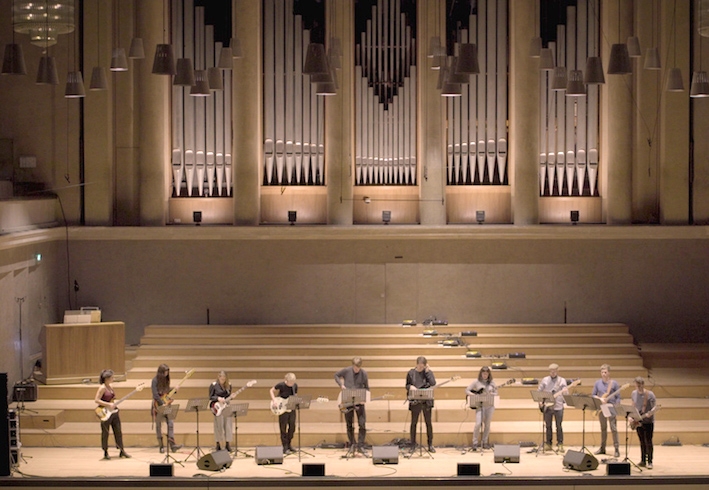Herkulessaal der Residenz, Munich, 29 November
When it was rebuilt in 1957, after the bludgeoning it took during the war, Munich’s Herkulessaal was recreated to the exact dimensions it had as King Ludwig’s throne room. The hall still retains some of that old imposing grandeur – not to mention a certain notoriety amongst acousticians for its faltering high frequencies and limp reverberation. Though it has often been used by the symphony orchestra of Bavarian radio, this is clearly a room designed more for its pomp and ceremony than its sound.
Under the auspices of artgenève/musique, a platform for the sounding arts established by the Swiss art fair in 2016, Berlin-based composer-curator Augustin Maurs programmes an evening of performances by nine mostly female artists, that both play to and subtly subvert the grandeur of their surroundings. For a little over two hours, short time-based works by Susan Philipsz, Monica Bonvicini, Angela Bulloch, and others, will wrestle with the architecture of the space, alternately pummelling at the walls with volume or dazzling the stalls with light, in a show that treats music as myth and myth as music, playing each off against the other.
High on the walls of the Herkulessaal, above the upper balconies, are twelve panels depicting the labours of Hercules – we see the mythical Greek hero slaying the Nemean lion, capturing the Erymanthian boar, washing out the Augean stables, and so forth. Hercules himself, as the programme notes remind us, was reprimanded and punished by his lyre teacher Linus for his unmusical playing – for which the hero beat his teacher to death with his own instrument. Identifying with this chippy son of Zeus, Myth, Music, and Electricity, then, arrives as an evening of unmusic, or, like Hans-Ulrich Obrist and Philippe Parreno’s (2007) Il Tempo del Postino, a group show occupying not space but time.
It courts opera’s grandiosity while simultaneously attempting to undercut it
Parreno and Obrist’s extravaganza for the Manchester International Festival was dubbed “The world’s first visual arts opera” by the Independent newspaper and there’s something of the Gesamtkunstwerk about tonight’s performance too, with its taped overture of roaring beasts and slowed-down studio idents by Louis-Philippe Scoufaras (20th Century Lions, 2010), its fanfare of leather belt snapping by Monica Bonvicini (A Choir of Five, 2017), numerous other more-or-less histrionic solos, duos, and trios, and even some scene-changing music tapped from the geomagnetic fields by Nina Canell and Robin Watkins (The Luminiferous Ether, 2009). But as opera, Myth, Music, and Electricity resembles less the great Hercules operas of Handel, Cavalli, or Gluck; more the contemporaneous fashion for operatic pasticcios which cobbled together popular arias from existing works by different composers in order to fill space in a theatre’s schedule.
Whether the show is undermining music from within or undermined by music from without, I’m not entirely sure. Judged from either angle, there are some great standout moments. Artist duo Sarah Schönfeld and Louis-Philippe Scoufaras’s PPKK 04.00 (2017), for which female body builder Beate Edwards flexes and poses while operating a line of seven Technics turntables bearing pitched sine tones and field recordings from an industrial cow stable (thus, like Hercules himself in the Augean stables, cleaning shit with waves), is both sonorously lush and funny as hell. Susan Philipsz’s Air on a Broken String (2015), in which three violinists studiously avoid their G strings, gains tremendously in dramatic tension transposed from its original looped three-speaker installation set-up (at the National Gallery two years ago) to a concert version with live instrumentalists. Karin Sander’s Blitz Concert (2008), dazzling its audience with a team of twenty on a darkened stage, all firing flashing cameras to the tune of remembered nursery rhymes, contracts the extended time of memory into the relative blip of a concert and makes compelling – thought silent – music out of the twinkling rhythms of burst clusters of lights.
But what’s really at stake in an event that takes its venue and form from the world of music but its patronage and legitimation from the art world? Myth, Music, and Electricity is funded by Swiss art fair, Art Genève, and populated by big name visual artists but housed in a concert hall and shaped like an opera. It courts opera’s grandiosity while simultaneously attempting to undercut it, with deliberately flat lighting and unfussily workmanlike changeovers between acts. It repeatedly translates musical structures into image (as in Sander’s Blitz Concert) and image into music (in, for instance, Augustin Maurs and Angela Bulloch’s closing collaboration, which made a composition for ten electric bassists out of the measurements of Bulloch’s sculptures). Like the demi-god who lends this hall his name, Myth, Music, and Electricity is a work in-between – and very self-consciously so.
the evening’s intent seems to be less a question of building bridges or initiating dialogues, than offering correctives and asserting a certain superiority
Nonetheless, the evening’s intent seems to be less a question of building bridges or initiating dialogues, than offering correctives and asserting a certain superiority. In an interview before the event with local culture magazine Reflektor M, the night’s curator Augustin Maurs claimed that musicians tend to neglect their surroundings, to perform as if ex nihilo, a fault he hopes to correct with the help of visual artists. It is an odd accusation to be levelled from an art form used to exhibiting in white cubes at another form which has encompassed important site-specific works since at least as far back as Iannis Xenakis’s Polytopes and Meredith Monk’s cantatas, if not all the way to Parsifal at the Bayreuth Festspielhaus and the famous split choirs employed by Renaissance composers at St. Mark’s basilica in Venice. But then, it is an even odder situation that one species of art-making, descended institutionally from painting and sculpture, might now encompass every media going but only in order to commit patricide on the genres it parasites upon, and claim for itself sole ownership over the name of art per se.
